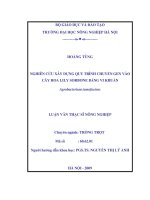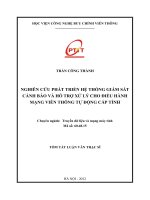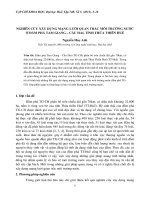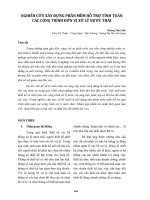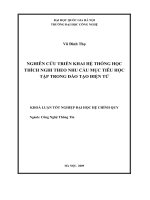Nghiên cứu xây dựng hệ thống kích thích tế bào thần kinh và ứng dụng trong đánh giá đáp ứng không gian của tế bào vị trí hồi hải mã
Bạn đang xem bản rút gọn của tài liệu. Xem và tải ngay bản đầy đủ của tài liệu tại đây (3.72 MB, 134 trang )
MINISTRY OF EDUCATION AND TRAINING
MINISTRY OF NATIONAL DEFENCE
ACADEMY OF MILITARY SCIENCE AND TECHNOLOGY
TA QUOC GIAP
RESEARCH ON ESTABLISHING THE NEURAL
STIMULATION SYSTEM AND APPLY FOR
EVALUATING THE SPATIAL RESPONSE OF
HIPPOCAMPAL PLACE CELLS
DOCTOR OF ENGINEERING DISSERTATION
HANOI - 2020
MINISTRY OF EDUCATION AND TRAINING
MINISTRY OF NATIONAL DEFENCE
ACADEMY OF MILITARY SCIENCE AND TECHNOLOGY
TA QUOC GIAP
RESEARCH ON ESTABLISHING THE NEURAL
STIMULATION SYSTEM AND APPLY FOR
EVALUATING THE SPATIAL RESPONSE OF
HIPPOCAMPAL PLACE CELLS
Specialization: Electronic engineering
Code: 9 52 02 03
DOCTOR OF ENGINEERING DISSERTATION
SUPERVISORS:
1. Dr. NGUYEN LE CHIEN
2. Dr. LE KY BIEN
HA NOI - 2020
i
DECLARATION
I hereby declare that this dissertation is my original work. The data and
results presented in the dissertation are honest and have not been published in
any other work. References are fully cited.
10th January, 2020
giả luận án
TA Quoc Giap
ii
ACKNOWLEDGMENTS
First and foremost, I would like to express my deep appreciation to my
direct supervisors, Dr. NGUYEN Le Chien, Dr. LE Ky Bien and Association
Professor TRAN Hai Anh, who enthusiastically guided me during my whole PhD
time. Thank you very much for many meaningful advices and discussion for my
work. I learnt from the mentors not only techniques for fulfilling my PhD work,
but also methods for solving problems in a lab as well as in the life. Thank you
very much for revising my thesis, giving me helpful comments and advices.
My sincere appreciations must go to other teachers in the Departments
for their encouragement, knowledge sharing, supports and helps in our course
and conduct the thesis.
I would like to express my sincere thanks to the Institute of Electronics –
Academy of Military Science and Technology; Department of Physiology,
Department of Material Equipment – VietNam Military Medical University,
where I study, live and work for creating favorable conditions for me to
participate in studying and researching during my time as a PhD student.
I want to express my special thank to the leader of Academy of Military
science and technology and other collaborator centers for their support and
help for this work.
Finally, I would like to thank my family members for their love,
encouragement. And especially, I would thank my wife who have sacrificed a
lot of things for supporting me to fulfill my PhD work.
iii
TABLE OF CONTENTS
Page
LIST OF SYMBOL AND ABBREVIATION………………………………..v
LIST OF FIGURES AND TABLES…………………………………………ix
INTRODUCTION............................................................................................ 1
CHAPTER 1
OVERVIEW ABOUT ELECTRICAL ACTIVITY OF NEURONS................6
1.1. Membrane potential of neurons................................................................. 6
1.1.1. Structure of nerve cells membrane......................................................6
1.1.2. Resting and action potential................................................................9
1.2. Electrical nerve stimulation and medical significance.............................12
1.3. The response of cell membranes to electrical stimulation....................... 16
1.4. The recording methods of the neuronal action potential..........................18
1.5. Hippocampus and hippocampal place cells............................................. 21
1.5.1. Structural characteristics...................................................................21
1.5.2. Function of the Hippocampus...........................................................21
1.6. Fundamentals of electronic circuit model of neuron............................... 23
1.7. Related research to this dissertation.........................................................26
1.8. Chapter conclusion...................................................................................29
CHAPTER 2
EQUIVALENT ELECTRICAL CIRCUIT MODEL .........................................
AND NEURONAL ELECTRICAL STIMULATION ALGORITHMS.........31
2.1. Electronic model of neuron membrane and assessment of electric
stimulation parameters....................................................................................32
2.1.1. Electronic circuit model of neurons..................................................32
2.1.2. Simulation of stimulating parameters on Maeda and Makino models
.....................................................................................................................34
2.1.3. Simulation results and discussion.....................................................36
2.2. The system for stimulation and recording the electrical activity of neurons.. 39
2.3. Building electrical stimulation algorithm model for neurons..................41
iv
2.3.1. Model and algorithm of electrical stimulation of neurons with NPT
test...............................................................................................................41
2.3.2. Model and algorithm of electrical stimulation of neurons with spatial
response tests...............................................................................................47
2.4. Chapter conclusion...................................................................................63
CHAPTER 3
EVALUATING THE STIMULATION ALGORITHMS AND...........................
THE SYSTEM BY BEHAVIOURAL RESPONSES AND ...............................
PRACTICAL EXERCISES ON MICE.......................................................... 64
3.1. Materials and methods............................................................................. 64
3.2. Simulation results.....................................................................................67
3.2.1. Simulation of the NPT task...............................................................68
3.2.2. Response simulation in spatial exercises.......................................... 69
3.3. Analyze and evaluate experimental results on mice................................ 74
3.3.1. Experimental results performed on NPT test....................................74
3.3.2. Experimental results performed on the spatial response tests...........79
3.4. The results of stimulating and recording experiments of the neuronal
electronic activity in the hippocampus on mice………………………………80
3.4.1. Unit isolation and recording………………………………………..80
3.4.2. Common characteristics of hippocampal place cells………………..82
3.5. The evaluation of the algorithms, stimulation and recording systems for the
electrical activity of neurons…………………………………………………83
3.5.1. The evaluation of algorithms………………………………………..83
3.5.2. The evaluation of stimulating and recording system for the electrical
activity of neurons.......................................................................................86
3.6. Chapter conclusion...................................................................................94
REFERENCES..............................................................................................100
APPENDICES …………………………………………………………………
v
LIST OF SYMBOLS AND ABBREVIATIONS
Ions concentration
Capacitance of the membrane per unit plane
cr
The adjusted response number
countInterVal
Number of stops to adjust the parameter
delayTime
The minimum time from when the mouse receives the
reward until the new reward area appears
deltaTime
The time it takes to count from the time the mouse receives
the prize until the new reward area appears
delta
Limits the distance the mouse moves to get the reward
The distance the mouse moves over a certain period of time
in the DMT test
The distance the mouse moves over a certain period of time
in the RRPST test
The distance the mouse moves over a certain period of time
in the PLT test
Diameter on the horizontal axis of the virtual environment
Diameter on the vertical axis of the virtual environment
Action potential of cell
Resting potential of cell
̅
Electric field strength
Faraday constant
Conductivity of Na+ ion channels
+
Conductivity of K ion channels
Conductivity of secondary ion channels
Interval
Interval to stop for parameter adjustment
Intra-axonal current
vi
Cell membrane stimulated current
Extra-axonal current
Stimulation current per unit of time
K
IN
K
OUT
Intracellular K+ concentration
Extracellular K+ concentration
maxT
The maximum time of task
maxPt
The maximum number of
maxwidth
rewards Radius of mice area
M50
moving 50 percent of the optimal
M70
70 percent of the optimal
M80
80 percent of the optimal
n
Valence of ions
N
a
N
a
OUT
Extracellular Na+ concentration
IN
Intracellular Na+ concentration
Constant
1
2
Membrane resistance per unit area
Absolute temperature
Time to stimulate
Rewarding eligible time
Reward receiving time
Pt
–
Total amount of exercise time for the mouse
Training time (also the total time of sessions)
Rest time to adjust the value of the stimulating parameter
Membrane potential
Number of rewards.
Transmembrane potential of Na+ channel
–
vii
–
′
̅̅
Transmembrane potential of K+ channel
Transmembrane potential of secondary channels
Electric membrane charge
The mean of movement speed of the mouse in the open
x0, y0
environment
xs, ys
Maximum diameter in the horizontal axis of the virtual
environment
xt ,yt
Minimum diameter in the horizontal axis of the virtual
xz1, yz1
environment
xz2, yz2
Reward coordinates of mouse before t
The coordinates of the mice at the time t is assigned with
xzt, yzt
1
2
wz
x0, y0 which is the original position of the mice Reward
coordinates of mouse at
The x and y coordinates of the center of the reward area 1
The x and y coordinates of the center of the reward area 2
x, y coordinates of the center of the current reward area
Maximum diameter in the vertical axis of the virtual
environment
Minimum diameter in the vertical axis of the virtual
environment
Reward region 1
Reward region 2
Radius of the reward area
System latency
System latency in DMT test
System latency in NPT test
System latency in RRPST test
viii
0
0
cr
AD
BSR
CCD
DAC
DC
DMT
EBS
EF
FPS
HNM
ICSS
MCI
MFB
MTLE
NPT
OF
PLT
RND, RRPST
SPF
SNR
System latency in PLT test
Inner membrane potential
Outer membrane potential
Membrane time constant
Response threshold
Correction threshold
Alzheimer’s disease
Brain stimulation reward
Charge coupled device
Digital analog converter
Direct current
Distance movement task
Electrical brain stimulation
Extracellular field
Frames per second
Hippocampal network model
Intracranial self – stimulation
Mild cognitive impairment
Medial forebrain bundle
Mesial temporal lobe epilepsy
Nose – poking task
Open – field
Place learning task
Random task, random reward place search task
Spike potential field
Signal to noise ratio
ix
LIST OF FIGURES
page
Figure 1.1. Basic structure of nerve cell……………………………………... 7
Figure 1.2. Concentration and potential of ions at rest………………………. 9
Figure 1.3. Direction of potential field lines around a neuron…………….... 11
Figure 1.4. Changes in membrane potential under the effect of stimulation
pulses……………………………………………………………………. 13
Figure 1.5. Dopamine transmission pathways of mesolimbic……………… 14
and mesocortical systems…………………………………………………… 14
Figure 1.6. Cell membrane’s response to stimulus signals………………… 16
Figure 1.7. Demonstration of extracellular potential recording technique and
the data form.............................................................................................19
Figure 1.8. Diagram of rodent brain and the location of the hippocampus… 21
Figure 1.9. Experimental equipment for the formation of the axon cable
equation………………………………………………………………… 23
Figure 1.10. Electronic circuit model and voltage chart of neurons…………24
Figure 2.1. Electric model of neron and the theory of action potential………32
Figure 2.2. Electrical neuron model according to Maeda and Makino………34
Figure 2.3. Electric model of a neuron
under the stimulation of direct
current…………………………………………………………………...35
Figure 2.4. One-dimensional stimulation pulse form with specified
parameter………………………………………………………………... 36
Figure 2.5. The voltage response pattern of the model…………………….. 37
Figure 2.6. Voltage change by stimulating intensity at 80Hz……………… 38
Figure 2.7. Change in voltage by stimulation frequency, at the intensity of
70μA…………………………………………………………………….. 39
Figure 2.8. Model of stimulating and recording the potential of neurons….. 40
x
Figure 2.9. The integrated control pulse pattern of the system and the neuron
stimulation pulse………………………………………………………... 41
Figure 2.10. Model of system for stimulating and responding to nose-poke
behavior………………………………………………………………… 42
Figure 2.11. Flow chart of the NPT test……………………………………. 45
Figure 2.13. Stimulating algorithm flowchart for DMT test……………….. 51
Figure 2.14. The system for stimulation and recording the action potential of
neurons on mice………………………………………………………… 53
Figure 2.15. Algorithm flowchart for the RRPST test……………………... 57
Figure 2.16. Flowchart of electric stimulation algorithm for PLT test……... 61
Figure 3.2. The recording chamber for the ICSS response and………………..
nose-poking behaviors of mice………………………………………………66
Figure 3.3. The illutration of the model and the arrangement of the spatial
tasks……………………………………………………………………... 66
Figure 3.5. Program interface in DMT test…………………………………. 70
Figure 3.6. Program interface in RRPST test……………………………….. 71
Figure 3.7. Program interface in PLT test…………………………………... 72
Figure 3.8. Relationship between nasal poking behavioral response and
intensity of stimulation…………………………………………………. 77
Figure 3.9. The dependence of nose-poking response on the stimulating
frequency…………………………………………..………..................... 78
Figure 3.10. Experimental results are analyzed for the spatial response
tests………………………………………………………………………80
Figure 3.11. The neuron activity are recorded and isolated using an offlinesorter program (Plexon)………………………………………………… 81
Figure 3.12. Electrical activity of neurons recorded at hippocampus……… 82
xi
Figure 3.13. Model of evaluating the stability and latency of the system for NPT
task by labchart Pro v8.1.8……………………………………………… 86
Figure 3.14. The illustration for pulses of the reward condition, reward
delivery, and the delay time of the system……………………………… 87
Figure 3.15. The evaluation of the stability and delay of the system for the
DMT, RRPST and PLT tasks…………………………………………… 87
Figure 3.16. Program to evaluate the stability and latency of DMT test…… 88
Figure 3.17. Graph of system latency time in DMT test…………………… 89
Figure 3.18. Program to evaluate systemic stability and latency in RRPST
test………………………………………………………………………. 90
Figure 3.19. Graph of system latency time in RRPST test…………………. 90
Figure 3.20. Program to evaluate systemic stability and latency in PLT test. 91
Figure 3.21. Graph of system latency time in PLT test…………………….. 92
1
INTRODUCTION
1. The necessity of the dissertation
Biomedical engineering is an applied science field, which connects
different sciences from physics, chemistry, and biology to electrical, control,
information, micro and nano technologies in order to provide biomedical
solutions for improving human health. Neural engineering is an important
subfield of biomedical engineering, which uses engineering techniques to
treat, replace, or restore the functions of the neural system. One of the central
field of neurophysiology is the study of the mechanisms of memory and
information storage in the brain [8], [48], [73], [87 - 89]. It requires a device
possessed controllable and stable properties for studying the mechanism of
memory storing in the brain. This plays an important role in a comprehensive
understanding of physiological neural system. Therefore, the development of
systems that allow studying the physiology of the nervous system has highly
practical applications.
Based on the available but functionally limited equipments and
programs, many supportive equipment and programs is needed for the system
to be functionally competent.
In this dissertation, a neural stimulation and recording sytem is
developed for evaluating behavioral and spatial responses of mice from
electrical stimulations with proper algorithms. This system allows deeper
understanding of the working principles of neurons and the brain. In addition,
this is fundamental to study the structure and function of hippocampus, which
may be associated with some neurodegenerative diseases such as Alzheimer’s,
mild cognitive impairment, mesial temporal lobe epilepsy, and Schizophrenia
[5 - 6], [23], [41], [68], [78].
The practical exercises with their respective algorithms are first built on
animals in order to develop the electrical stimulating and recording system for
2
neurons. The built stimulation system allows the electrical activities of
neurons to be evaluated in environment and whole living organism
correlations. The electrical recording of neurons in hippocampus is
fundamental to assess cells’ behavior in this place. Importantly, specific
working principles of the central nervous system will be elucidated to better
understand feeling, memory, and autonomic nervous mechanisms.
Therefore, the project “research on establishing the neural stimulation
system and apply for evaluating the spatial response on hippocampal place
cells” has a practical role in comprehensive studies of neuronal physiology.
2. Objectives
-Developing a system for stimulating and recording the electrical activity
of neurons based on electronics engineering.
- Building mathematical algorithms of neuronal stimulation for 4
practical exercises on mice.
3. Subjects and scope of research
In order to build an electrical stimulation system which targets the
"reward" mechanism of the central nervous system, the study and
development of a stimulating control program system with appropriate
equipments including:
- Single - channel Stimulator SEN - 3401 (Nihon Kohden, Japan).
- Digital - Analog converter (DAC) and Isolator SS - 203J (Nihon Kohden,
Japan).
- Nose - poking chamber.
- Control program is built on C++ language, version 2010 (Microsoft Inc.,
USA); data structure and data collection program is built on C# language,
version 2010 (Microsoft Inc., USA).
Recording the response potential of the hippocampal place cell when the
animal moved in given environment. Microelectrodes were placed in the
3
hippocampus of mice, and the cell potential field was recorded as animals
moved through C++ and C# - based drivers developed for research purposes,
the experimental tests are built based on the corresponding algorithm.
Equipment used in recording neuron electrical activity and programs for
recording, analyzing data and evaluating system activities and developed
algorithms, including:
- Plexon HLK2 system (Plexon Inc., USA) could record the action
potential of the hippocampal place cells and the spatial location of
animals in the open environment.
- Measure the resistance of the recording electrode: Electronic Balance
(Shimadzu Corporation, Japan).
- Programs have been developed and applied in the characteristic analysis
of hippocampal place cells activities.
4. Methodology
The thesis uses circuit theory to simulate electric stimulation parameters
by NI Multisim program version 14.0 (National Instruments Inc., Australia);
mathematical statistical theory in experimental tests on mice; biomedical
techniques in implementing research systems, especially in setting up
stimulating electrodes and electrodes for recording the electrical activity of
neurons; theory of digital signal processing in signal visualization and
mathematical model formulation of the problem. Simulation program,
algorithmic models building, experimental methods description on mice and
data results with C# programming language (Microsoft, USA). System
controlling and synchronization with C++ programming language (Microsoft,
USA). Using intensive developed software to analyze the collected data as a
basis for evaluating built algorithms and system. Moreover, these results show
characteristics of hippocampal place cells in relation to a given environment.
5. Content and structure
4
Apart from Introduction, Conclusion and References, this dissertation
contains 3 chapters as follow:
Chapter 1. OVERVIEW ABOUT ELECTRICAL ACTIVITY OF NEURONS
Chapter 1 presents an overview of the membrane potential of neuron, such
as: the structure and function of the cell, the membrane of the neuron; theory
of resting and action potentials; the function of hippocampal place cells.
In assessing the electrical activity of neuron, it is necessary to build a
system capable of evaluating the neuronal electrical activity characteristics
under the influence of stimulating factors. Chapter 1 introduces the modeling
of the response of the nervous system in relation to the "reward" mechanism
for electrical stimulation, which is the basis for simulating the electrical
stimulation and response of the cell membrane carried out in Chapter 2.
The electrical activity of the cell membrane induces changes in the
extracellular potential field. Therefore, chapter 1 also provides the technical
knowledge as well as the electrical activity recording system of neurons.
Chapter 2. EQUIVALENT ELECTRICAL CIRCUIT MODEL AND
NEURONAL ELECTRICAL STIMULATION ALGORITHMS
In chapter 2, using electronic models of neurons to examine electrical
stimulation parameters and select appropriate parameters as the basis for
building experimental stimulating parameters on animals.
Besides, chapter 2 also proposes 4 models and 4 algorithms to apply in
the tests related to brain stimulation reward (BSR) from suitable parameters
(frequency, amplitude) simulated and verified through experiments in building
model, algorithm for intracranial self-stimulation (ICSS) with response to
nose-poking through NPT test. Algorithms and drivers are applied to develop
reward-seeking exercise test in an open field, thereby assessing the potential
activity related to spatial memory of hippocampal place cells.
5
Chapter 3. EVALUATING THE STIMULATION ALGORITHMS AND THE
SYSTEM
BY
BEHAVIOURAL
RESPONSES
AND
PRACTICAL
EXERCISES ON MICE
This chapter presents the simulation results before the experiments and
the experimental results on the system through exercises performed on mice,
using the stimulation models and algorithms proposed in Chapter 2. Utilizing
evaluation methods and analyzing the obtained results is the basis for
evaluating the stimulation algorithm model and the system for stimulation and
recording the electrical activity of the built neuron.
6. Scientific and practical signification
From the understanding of electrical activity of neurons, the thesis has
investigated the frequency and amplitude parameters of stimulation pulses
through modeling electronic circuit of neurons. This is the basis for assessing
the response of neurons to DC stimulation parameters through intracranial
self-stimulation (ICSS). From there, to suggest the suitable stimulation
parameters for the study subject.
From the signification and widely role of electrical stimulation in
medicine, the dissertation has proposed the construction of a system for
stimulation and recording the electrical activity of neurons along with 4
algorithms of electrical stimulation of neurons in 4 experimental tests on
animals. In addition to the proposed research facilities, these four tests help to
assess the spatial response of the "reward" system in the brain and neurons in
a given environment. These results contribute to the electrical function
evaluation of neurons, which is the basis for assessing the physiological
activity of the central nervous system.
The thesis also addresses the need to synchronously built and develop
the system and program to stimulate and record neuronal electrical activity to
solve the current problem in functional research of the central nervous system.
6
CHAPTER 1
OVERVIEW ABOUT ELECTRICAL ACTIVITY OF NEURONS
The study of characteristics, especially the electrical properties of cell
membranes and the effect of electrical stimulating parameters on neurons
serves as a basis for building an algorithmic model and a neuron stimulation
system. The successful combination of a neuronal stimulation system with the
recording of electrical activity of neurons into a complete system is important
to evaluate the activity of each neuron in relation to the environment and the
whole organism. Research in building neuron stimulation system and
recording the electrical activity of hippocampal nerve cells will help medical
researchers to evaluate the operational characteristics of the hippocampal
place cells under the influence of several stimuli in the environment.
1.1. Membrane potential of neurons
1.1.1. Structure of nerve cells membrane
Neurons are analogous to other cells, which have structural components
of cell membranes, nuclei and organelles. The electrical activity of normal
cells as well as neurons is highly related to the structure and characteristics of
the cell membrane [1].
Nerve cells (also called neurons) are composed of three main components,
the cell body, dendrites and axons, which are visualized in Figure 1.1 [10].
The cell body (also called the soma) is the largest part of the neuron,
containing the nucleus and the majority of the cytoplasm (the physical space
between the nucleus and the cell membrane). Most of the cellular metabolism
takes place here, including the production of Adenosine Triphosphate (ATP)
and the synthesis of proteins. The neuron body processes and makes decisions
about the flow of information going to and from here.
7
Dendrite are short tentacles that develop from the cell body. This is
where the signal pulse from other nerve cells is transmitted (afferent signals).
The action of these impulses may cause excitation or inhibition at the
receiving neuron. A nerve cell in the brain cortex can receive afferent
impulses from tens or even hundreds of thousands of neurons.
Figure 1.1. Basic structure of nerve cell.
Axon is the only long extension that develops from the cell body. Axons
carry the processed signal pulse from the cell body to another cell such as
neuron or myocyte, adenocyte, ... The diameter of the axon in a mammal in
the range of 1 - 20µm. In some animals, the axon can be several meters long.
The axon may be wrapped by an insulating layer called a myelin sheath, made
by Schwann cells. The myelin sheath is not seamless but is divided into
segments. Between Schwann cells are the nodes of Ranvier. The structural
characteristics of the Myelin sheath and the nodes of Ranvier have a great
influence on the speed of impulse conduction on nerve fibers.
8
Similar to other cells in the organism, neurons are surrounded by a 7.5–
10nm cell membranes. The cell membrane plays a very important role in
establishing the resting properties and electric activity of the cell when
stimulated by regulating the movement of ions between extracellular and
intracellular spaces. Some ions such as HCO 3-, Cl- ... could move to both sides
through cell membrane easily due to the difference in concentration gradient. But
some of the ions, especially Na
+
and K
+
must follow selective transport
mechanism to move through cell membrane. This leads to a potential gradient
between the two sides of the membrane and creates a potential field. This field
exerts force on ions across the cell membrane. Therefore, the movement of
membrane ions is influenced by both the electric and diffusion forces.
The existence of a cell membrane depends on the permeability of the
necessary substances from the external environment into the cell and the
excretion of metabolites and debris from within the cell. The permeability or
transportation of substances through the cell membrane is carried out in the
forms of direct transport, phagocytosis, pinocytosis and exocytosis. Direct
transportation of substances through the membrane can be divided into three
categories: diffusion, passive transport and active transport [1].
The resting potential of ions in a cell is described in Figure 1.2 [52]. The
+
+
-
2+
main ions are potassium (K ), sodium (Na ), chlorine (Cl ) and calcium (Ca ).
+
In particular, the electrical activity of the cell is mainly determined by K and
+
+
+
Na ions. The activity of K and Na ions respectively determines the resting
potential and the action potential of the cell membrane. The potential equilibrium
is obtained when the diffuse force is equal to the electric field force of all ions.
For membrane with selective permeability of only one type of ion, equilibrium
condition is when the electric field creates a force equal to and in opposite
direction to the diffuse force. The steady-state values of the membrane
9
potentials when there are some forms of ions in the intracellular and
extracellular environments, as they cross the cell membrane, are specifically
described in the Goldman - Hodgkin - Katz voltage equation [26], [61].
Figure 1.2. Concentration and potential of ions at rest.
1.1.2. Resting and action potential
The membrane potential of a cell is defined as the difference in potential
between the internal and external side of the membrane due to the difference
between ions on either side. At rest, the ions distributed on both sides of the
membrane are in equilibrium and depend on two forces - diffusion and
+
electrostatic forces. The ions diffused out in the resting cell state are mainly K ,
+
so the diffusion force is calculated by the work needed to pass 1 mole of K ions
across the membrane. The electrostatic force at rest is calculated by the work
needed to resist the repulsion of ions with the same sign and the attraction of the
+
opposite ions, in order to transfer a mole of K ions across the membrane
10
[1]. Thus, in order to pass a mole of ions across the membrane, a total force
(called electrochemical potential) is needed, which is equal to the sum of the
diffuse and electrostatic forces and when the ions are in equilibrium, the two
forces are equal (but opposite). In the resting state (polarized state), the
resting voltage Ek, determined by the K+ ion, is calculated using the Nernst
equation and usually fluctuates between -70mV and -90mV and the cell
membrane is now in a polar state.
E
K
RT K
nF ln
K
(1.1)
OUT
IN
in which:
- R: constant [8.314J/(mol.K)]. It is the kinetic energy of 1 mol of ions
moving in an environment of 1°C.
- T: absolute temperature.
- K+IN and K+OUT : K+ ion concentrations inside and outside the cell,
respectively.
- n: valence of ion; with K+, n = 1.
- F: Faraday constant (electric charge per mole of electrons).
When the cell is excited, the membrane potential is changed by changing
+
+
the permeability of the membrane with Na ions. The Na channel is opened, and
+
the Na ions on the outside of the membrane rush into the cell to redistribute ions
on either side of the membrane: the number of positively charged ions on the
inside of the membrane is greater than on the outside. At this time, the membrane
is polarized from the polar state to the depolarized state and the excited or action
potential EA appears. This potential originates from the stem cell along the axon
and is conducted to other cells. The operating potential value can reach 120mV
but because at the starting point the membrane potential
11
(in the polarized state) has a value of -90mV, the actual voltage is about +
30mV.
E
RT ln Na OUT
(1.2)
nF
N
a IN
After excitation, the cell membrane gradually returns to its original state,
A
which means that repolarization takes place through the operation of the Na +K+ pump. The result of this process is to re-establish the balance of positive
and negative charges on both sides of the cell membrane as before excitation
[1]. This phase is called the repolarization phase.
Figure 1.3. Direction of potential field lines around a neuron.
When depolarizing neuron membrane generates action potentials, they
increase the electrical conductivity of the excitation-sensitive areas of the
membrane such as at the axon hillock or the soma. The potential current enters
the cell through these locations into the core of the cell and then out to the
membrane located at nearby inactive positions and returns to the place where the
potential current enters through many different ways. This process forms a
potential electric field around the neuron and its properties depend on the size
12
and shape of the cell, as well as the position and time on which the
membrane’s conductivity is enhance [42], as described in Figure 1.3.
The term EF (extracellular field) or SPF (spike potential field) mentions
the potential field around an active neuron when producing potential pulse.
The membrane voltage of an excitable cell is defined as the potential on the inside surface of the
membrane compared to the outside surface potential 0:
(1.3)
= −
0
(
)
This definition is independent of the cause of the potential and whether
the membrane voltage is constant, periodic or non-periodic in operation.
Fluctuations in the membrane potential can be classified according to their
properties in a variety of ways. According to Bullock [15], the transmembrane
potential transmissions can consist of resting and changing potentials due to
activity. When there is a series of stimuli to the cell membrane, a certain
degree of response potential is induced. If the amplitude of the response
potential is small and does not exceed the threshold, the response is not
propagated (electric tone). If the response is strong enough, a nerve impulse
(action potential impulse) will be produced according to the "all or none" rule.
1.2. Electrical nerve stimulation and medical significance
The basic theory of cells in general and neurons in particular is the basis
for assessing the stimulation and response of neurons to stimuli, in which the
stimulation with an electric impulse plays an extremely important role in the
intensive study of neurons.
When a neuron is stimulated, the membrane potential of the cell changes.
After response to stimulation, the membrane potential returns to its initial
resting value. If the membrane stimulation is insufficient to induce a
transmembrane potential that reach the threshold, the membrane will not be


